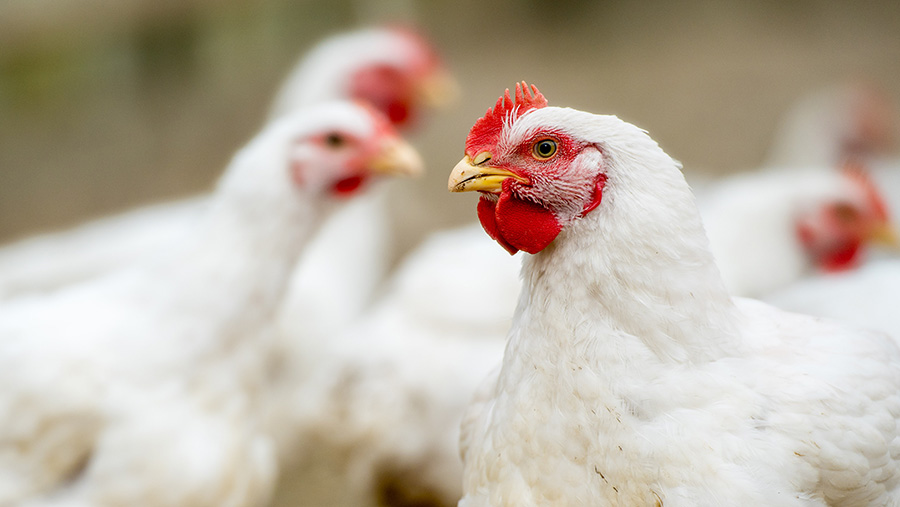Outlook 2024: Poultry price pressure set to remain through 2024
 © Snowboy/Adobe Stock
© Snowboy/Adobe Stock The UK poultry sector has suffered many challenges over the past 12 months and beyond.
It looks set to continue on a rollercoaster ride through 2024, according to Andersons consultant Edward Calcott.
Layer chick placings have once again rocketed, which will begin to increase supply into the New Year.
With demand remaining suppressed, this can only mean prices heading in one direction.
See also: Outlook 2024: Flat milk prices will prompt dairy costs review
As in the past, lower production should mean more profit/cash for the poultry sector.
Poultry market summary
- Layer chick placings have risen sharply but demand remains suppressed
- Price pressure looks set to remain through 2024
- Identify key challenges that have undermined and continue to affect performance and take steps to remedy them where appropriate
Communication is required between producers and processors to ensure supply and demand remain in balance and that prices reflect increases in costs.
Prices should also account for the profit requirement of each poultry business, to cover loan repayments, tax, drawings and reinvestment.
In the shorter term, identifying and tackling the challenges that have undermined the sector in recent times will help commercial UK producers relieve at least some of the pressure.
The most prominent challenges are:
- Avian influenza
- Energy price inflation
- Threat from imported egg products which would be illegal to produce here (for example battery cages)
- Planning rules and restrictions for large units
- Labour issues
- Rising interest rates
- Low returns and lack of profitability.
All of these can affect the performance of the business, its stakeholders, its suppliers, and the morale of the people operating it.
Below, the focus is on solutions which producers should initiate where appropriate.
Avian influenza
Practice the best biosecurity possible. Restrict visitors to the site and limit access to the shed; have a good perimeter fence with a locked gate.
Ensure wheel wash facilities are adequate and encourage showering onto site, and provide personal protective equipment for visitors. In addition, practice good vermin control.
Consider an external audit to identify weak spots you may have missed. A fresh set of eyes and a second opinion is beneficial, perhaps from a neighbouring poultry farmer, enabling some mutualism.
Energy price inflation
Depending on existing contracts, tackling this can be difficult. Shop around suppliers where possible.
Ultimately, energy cost control stems from controlling usage.
Assess the payback from energy-saving items such as solar panels and heat exchangers before installing.
Once installed, track performance and challenge suppliers if the equipment is not performing as it should.
Also, challenge packers and processors to increase prices to reflect the investment.
Threat of imports
This is something largely out of the direct control of producers.
Liaising with poultry lobby groups and local MPs to influence policy is the best approach.
Promote British poultry on social media to educate consumers on the differences between domestic and imported produce.
Planning
For new sites, appoint an experienced planning agent and obtain pre-planning advice from the local council.
Prepare a very thorough application. Highlight any ammonia-reducing infrastructure you will install, along with robust lorry/transport routing plans.
Think carefully about the site location; it will be there for a long time.
Labour issues
Make your farm a good place to work. Poultry farming is a seven-days-a-week job, but it does not have to be nine to five, or even five to nine.
Promote flexible working within the day and encourage time off during quieter periods and between daily work patterns.
Become a leader, not a boss, and allow people to make decisions if they are capable.
Have periodic meetings with staff to discuss issues and involve them in the wider business, if appropriate, so they understand the bigger picture.
Interest rates and profitability
Business profit, cashflow and residual funds will be influenced to varying degrees depending on debt levels and whether these are fixed or variable.
Be proactive and budget to identify any cashflow pinch points so you can manage and address them with the lender in advance.
If you are unsure or require a second opinion, engage a farm business consultant to assist in this.
Challenge your suppliers and contractors. If their costs/charges have risen, respect that and make sure you still receive the same standards and quality of service.
Sometimes good relationships are worth more than money alone.
Likewise, for those farming within integrated supply chains, challenge your customers, packers and integrators on quality of service, support and price.
Put pressure on them for higher prices where appropriate, and quantify these. Ensure you receive feedback on birds and eggs.
Thank people where appropriate. Be a reasonable person to deal with and think about the longer-term strategy, rather than the short term.
